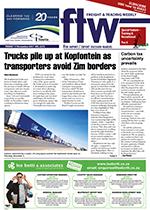The Kopfontein border post between South Africa and Botswana is buckling under the pressure as South African transporters seek new transit routes into Africa to avoid travelling via Zimbabwe. Some 1 181 and 1 429 trucks respectively crossed the border on November 2 and 3, resulting in kilometres-long queues. FTW was alerted to the problem last week when a transporter submitted a video of the queue outside the border post on November 2. It included an audio clip of a truck driver phoning his boss to say that he had been waiting in the queue for eight days and was tired and hungry. He had been given subsistence money but not enough for eight days. “Normally our trucks cross over the border in a day,” he said. Mike Fitzmaurice, CEO of the Federation of East and Southern African Road Transport Associations (Fesarta), told FTW that transporters should never stand at any border post for longer than a day as it cost money and was seen as a major barrier to trade. Neither Fesarta nor the Road Freight Association (RFA) had been alerted to a problem at the Kopfontein border but further digging by Fitzmaurice (who spoke to a transporter pictured in the queue) revealed that a South African Revenue Service (Sars) system reportedly had been down on November 2 and 3, but there had been no official communication. A Sars spokesperson told FTW that there had been no systems challenges during the two days highlighted “that they were aware of”. Feedback from other transport companies indicated that Kopfontein was experiencing high traffic volumes of late – regardless of whether systems were up or down. This, they said, was due to transporters avoiding transit through Zimbabwe because of that country’s raft of new transit regulations which were causing “massive delays”. “Kopfontein also has only one gate – compared to another SA/Botswana border post, Skilpadshek. There is absolutely nothing wrong with the Sars system, in fact Sars recently procured new machines,” a transporter told FTW. He advised transporters to divert cargo to Skilpadsek which he believed was big enough to accommodate a high volume of trucks. Another transporter confirmed that he had spoken to a “colleague” at Sars who had confirmed that Kopfontein was experiencing a “very high volume of traffic” and that the revenue authority had told him it was “closely monitoring the situation”. “I’m not sure that is a satisfactory response as other southern African borders will continue to experience higher volumes of traffic until the situation at Zimbabwean borders has been sorted out,” he said, pointing out that there had been no forward planning from Sars and other border authorities “whatsoever”. The Sars spokesperson acknowledged to FTW that Kopfontein’s one gate did create logistical problems when high volumes of trucks travelled through the border post. “The port of entry does not have a sufficient parking area to allow more trucks inside the controlled area,” he said, adding that “engagements with the Department of Public Works to upgrade/expand the Kopfontein facilities were “ongoing”. He told FTW that the Sars electronic data interchange (EDI) would be used to inform traders of any system upgrades/maintenance at any given time. Transporters and clearing agents were invited to monthly meetings with Sars customs management in the North West province to discuss and address any challenges, he said. “Transporters attending these meetings have contact numbers of operations managers, branch managers and senior managers for escalation purposes,” he said. However, both Fitzmaurice and the transporter who alerted FTW to the challenges at Kopfontein said there was never any communication from Sars regarding systems and other issues. Gavin Kelly from the RFA noted that if his association reported problems, “we have immediate response and follow-up”.
A photo, submitted by a reader, of a long queue outside the Kopfontein border post on Thursday, November 2.

